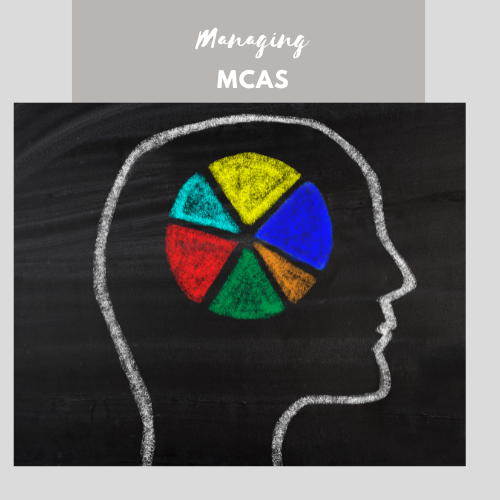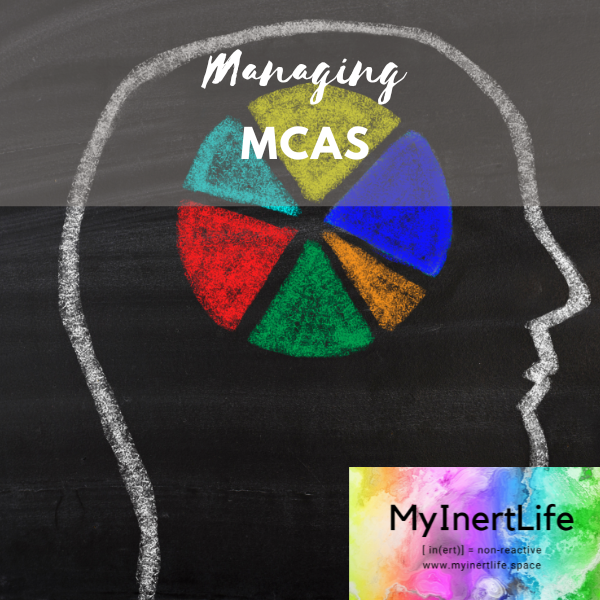
managing mcas
This post provides some practical tips for managing MCAS — specifically to address stress as a trigger for MCAS. Stress, toxins, and infections are the three underlying triggers for Mast Cell Activation Syndrome (MCAS). This post covers treatments that are helpful for vagus nerve injury and limbic system dysfunction, which fall under the category of “stress.” So how do you manage “stress”? Read to find out!

As an Amazon Associate, I earn from qualifying purchases.
Mast Cell Activation Syndrome (MCAS) is a chronic condition that affects all organ systems. MCAS is serious and disabling and people with MCAS experience often significant and debilitating symptoms daily, including anaphylaxis, which can be fatal.
MCAS is often found in combination with other chronic conditions such as Ehlers-Danlos Syndrome (EDS) and Postural Orthostatic Tachycardia Syndrome (POTS).
Frequently healthcare providers do not know about MCAS, and the tests for MCAS are problematic because they are not uniformly reliable. MCAS can be difficult to manage. Treatments include blocking mast cell mediators with anti-histamines and mast cell stabilizers, as well as avoiding triggers.
https://www.pinterest.com/pin/1054475700229975410/Stress, toxins, and infection all cause mast cells to dump their mediators, which brings inflammation to the affected body parts, further activating the mast cells. At the same time, your organ systems react to the increase in mast cell activity, causing more symptomatology, and furthering the cycle. The techniques and treatments listed below are also helpful for addressing infection and toxins indirectly.
Injury to the vagus nerve is a major trigger for MCAS which I discuss in this blog post. Vagus nerve treatments are linked there.
Some additional ways to calm the vagus nerve are:
Limbic system dysfunction is another big trigger of MCAS. The limbic system is the part of the brain that monitors for safety and controls emotion and sensitivity. Limbic system dysfunction contributes to anxiety, depression, OCD, and increased sensitivities. These sensitivities — from light, and touch, to foods, and environmental triggers — are common with MCAS patients. So you can see how having your limbic system regulated is part of the overall MCAS solution.
The SSP is a listening therapy based on Polyvagal Theory created by Stephen Porges to unlock your ability to think, feel, and connect better through nervous system regulation. You use the SSP via an app on your phone and listen with over-the-ear headphones to specially filtered music that heals the nervous system, specifically the vagus nerve. You subscribe to the app with a provider like me and listen to the specially curated music for 30 minutes each day for a 20-day cycle. Studies show the SSP has a profound effect on mental health and chronic conditions:
47% of clients using the SSP had fewer psychosocial challenges
If you’d like to learn more about the SSP, please reach out to me!
61% of clients using the SSP had reduced anxiety
54% of clients using the SSP had reduced depression
63% of clients using the SSP had fewer trauma symptoms
I’ve successfully used the SSP for vagus nerve healing and nervous system retraining since 2023. You can sign up for the SSP here!
These treatments help retrain the brain based on the notion of neural plasticity. You can change the way your brain functions by developing new ways of thinking about stressful triggers, and these techniques teach you how to do that.
What has helped my limbic system health the most is having a daily forgiveness practice to rewire my brain toward greater health and using the Safe and Sound Protocol for nervous system retraining.
If you are particularly sensitive you may not be able to follow these programs as they are designed but to start slower, and follow a regimen with fewer repetitions.
Knowing your symptom progression in a flare is the key to developing your own rescue plan. In this post, I discuss symptom progressions and ways you can figure out your own symptom progression. Once you know what typically happens in your symptom flares you can put together a rescue plan to address those symptoms.
Sign up for my newsletter and you will receive my free 50-page ebook of lower-histamine, grain-free, sugar-free, Keto recipes, my free symptom log, and a free two-week meal plan!
MCAS practitioners will tell you that the more ways you can gently address vagal and limbic system dysfunction at once, the better. However, because MCAS patients are so sensitive, you will need to start slow, and often adjust the program(s) to suit your particular sensitivities.
Other ways to approach the “stress” trigger for MCAS and address vagus nerve injury and limbic system dysfunction are:
Beneficial. Microcurrent Microcurrent – uses a tiny amount of electricity that runs through the body via electrodes or paddles for detox, to address specific infections. Beneficial microcurrent can be used for vagal health, to calm MCAS, to aid sleep, and for injury to the body in general. I have used FSM for several years and have found it to be a wonderful adjunct therapy while addressing underlying infections and other triggers.
I used beneficial microcurrent for several years to sleep better, heal vagus nerve injury, detox, and treat specific infections. This post and this post discuss it in more detail.
Emotional Freedom Technique (EFT) is another amazingly easy and effective technique for calming the limbic system. I have used EFT for over ten years. You can find a description of the basic technique in the link above, and you can find many YouTube videos online that show it in action. In an acute situation, you can also simply tap on one of the acupressure points, and it is helpful to reset your mind.
Cranio Sacral Therapy (CST) – There are two types of cranial sacral therapy: Osteopathic therapy, which is performed by a doctor of osteopathy, and Cranio Sacral Therapy (CST), which you can receive from massage therapists and chiropractors. Generally, the osteopathic variety is considered more effective for MCAS, but CST is also quite helpful and may be your only option depending on what is available in your area. This directory provides resources to find CST near you. Either way, the techniques are helpful in calming the nervous system.
I address toxins in this post and infections in this post.
The Safe and Sound Protocol (SSP) is a listening therapy based on Polyvagal Theory that helps heal nervous system regulation. Many people with MCAS have nervous system dysregulation stemming from infections, toxic exposures, concussions, and trauma. The SSP is an easy-to-use app where you listen to specially filtered music for 30 minutes each day for a 5-hour cycle. Studies show the SSP has a profound effect on mental health and chronic conditions
You can sign up for the SSP here!
Rocks and Roots chronicles my journey solo backpacking the Superior Hiking Trail and overcoming nervous system dysregulation, gut dysbiosis, and Mast Cell Activation Syndrome symptoms to hike 328 miles successfully.
Healy is an individualized microcurrent device I use to reduce inflammation. Check out this post for more about Healy.
I provide one-on-one in-person and remote chronic illness and caregiver coaching and Sacred Self-Healing Sessions based on the Sacred Self-Healing Method, a proven novel co-creative healing modality detailed in my Books.
Click here for more information.
I’d love to have your reply below!
The preceding material does not constitute medical advice. This information is for information purposes only and is not intended to be a substitute for professional medical advice, diagnosis, cure or treatment. Always seek advice from your medical doctor.
Did you know that Betsy offers chronic illness support coaching? This post discusses the benefits…
This post discusses the topic of what is the best nervous system retraining program. What…
This post discusses using binders for toxins when you have MCAS. Toxins are one of…
This post discussed a technique called the SSP thirty-second reset, which stops my MCAS symptoms…
This post is about the difference between dysautonomic temperature dysregulation and flushing. I experience temperature…
This post discusses why mycotoxins are triggering your MCAS, and what to do if they…
This website uses cookies.
View Comments